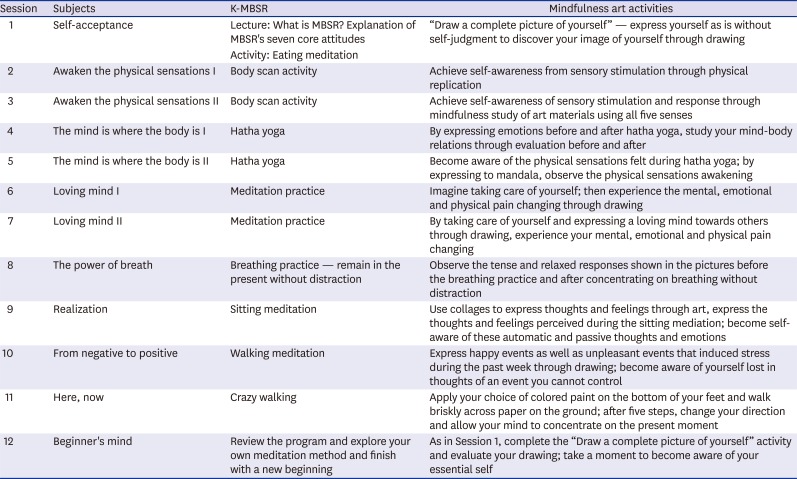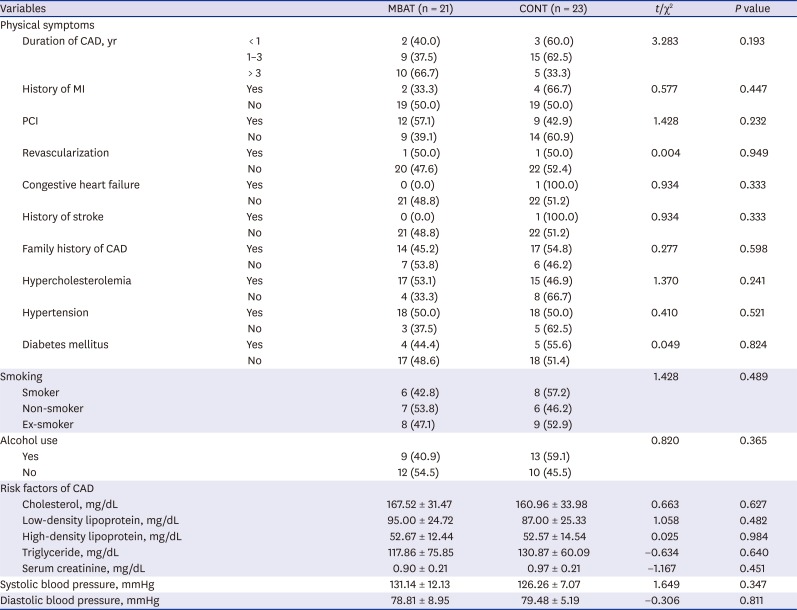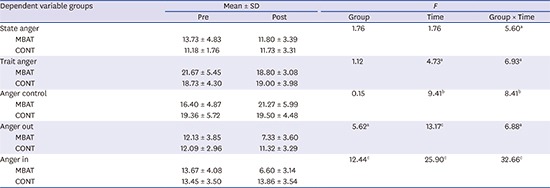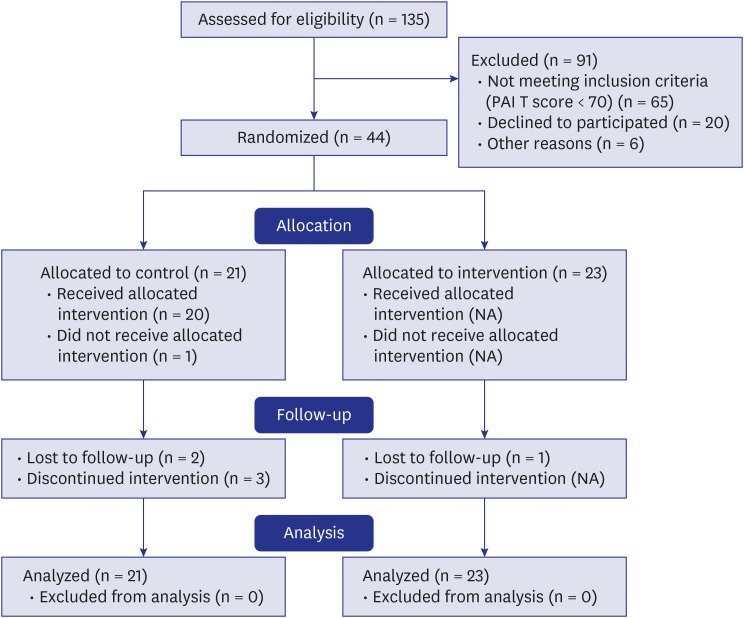1. Korean Statistical Information Service. Updated 2016. Accessed August 27, 2016.
http://kosis.kr/.
2. Lim ST. Assessment of prognosis and risk stratification in coronary artery disease. Nucl Med Mol Imaging. 2009; 43(3):222–228.
3. Kohli P, Whelton SP, Hsu S, Yancy CW, Stone NJ, Chrispin J, et al. Clinician's guide to the updated ABCs of cardiovascular disease prevention. J Am Heart Assoc. 2014; 3(5):e001098. PMID:
25246448.

4. Everson-Rose SA, Lewis TT. Psychosocial factors and cardiovascular diseases. Annu Rev Public Health. 2005; 26(1):469–500. PMID:
15760298.

5. Low CA, Thurston RC, Matthews KA. Psychosocial factors in the development of heart disease in women: current research and future directions. Psychosom Med. 2010; 72(9):842–854. PMID:
20841557.

6. Davidson KW. Depression and coronary heart disease. ISRN Cardiol. 2012; 2012:743813. PMID:
23227360.

7. Allgulander C. Anxiety as a risk factor in cardiovascular disease. Curr Opin Psychiatry. 2016; 29(1):13–17. PMID:
26575295.

8. Pimple P, Shah A, Rooks C, Bremner JD, Nye J, Ibeanu I, et al. Association between anger and mental stress-induced myocardial ischemia. Am Heart J. 2015; 169(1):115–121.e2. PMID:
25497256.

9. Chida Y, Steptoe A. The association of anger and hostility with future coronary heart disease: a meta-analytic review of prospective evidence. J Am Coll Cardiol. 2009; 53(11):936–946. PMID:
19281923.
10. Brydon L, Strike PC, Bhattacharyya MR, Whitehead DL, McEwan J, Zachary I, et al. Hostility and physiological responses to laboratory stress in acute coronary syndrome patients. J Psychosom Res. 2010; 68(2):109–116. PMID:
20105692.

11. Denollet J, Gidron Y, Vrints CJ, Conraads VM. Anger, suppressed anger, and risk of adverse events in patients with coronary artery disease. Am J Cardiol. 2010; 105(11):1555–1560. PMID:
20494661.

12. Buckley T, Hoo SY, Fethney J, Shaw E, Hanson PS, Tofler GH. Triggering of acute coronary occlusion by episodes of anger. Eur Heart J Acute Cardiovasc Care. 2015; 4(6):493–498. PMID:
25713468.

13. Kabat-Zinn J. Mindfulness-based interventions in context: past, present, and future. Clin Psychol (New York). 2003; 10(2):144–156.

14. Monti DA, Peterson C, Kunkel EJ, Hauck WW, Pequignot E, Rhodes L, et al. A randomized, controlled trial of mindfulness-based art therapy (MBAT) for women with cancer. Psychooncology. 2006; 15(5):363–373. PMID:
16288447.

15. Leventhal H, Diefenbach M, Leventhal EA. Illness cognition: using common sense to understand treatment adherence and affect cognitions interactions. Cognit Ther Res. 1992; 16(2):143–163.
16. Morey LC. The Personality Assessment Inventory. Odessa, FL: Psychologial Assessment Resources;1991.
17. Chang HK. Therapeutic application of meditation to the stress-related disorders. Korean J Health Psychol. 2004; 9(2):471–492.
18. Spielberger CD. State-Trait Anger Expression Inventory Professional Manual. Odessa, FL: Psychological Assessment Resources;1988.
19. Beck AT, Ward CH, Mendelson M, Mock J, Erbaugh J. An inventory for measuring depression. Arch Gen Psychiatry. 1961; 4(6):561–571. PMID:
13688369.

20. Han HM, Yum TH, Shin YW, Kim KH, Yoon DJ, Chung KJ. A standardization study of Beck depression inventory in Korea. J Korean Neuropsychiatr Assoc. 1986; 25(3):487–500.
21. Spielberger CD, Gorsuch RL, Lushene RE. STAI Manual for the State-trait anxiety inventory: (Self-evaluation Questionnaire). Palo Alto, CA: Consulting Psychologists Press;1970.
22. Abbott RA, Whear R, Rodgers LR, Bethel A, Thompson Coon J, Kuyken W, et al. Effectiveness of mindfulness-based stress reduction and mindfulness based cognitive therapy in vascular disease: a systematic review and meta-analysis of randomised controlled trials. J Psychosom Res. 2014; 76(5):341–351. PMID:
24745774.

23. Nyklíček I, Dijksman SC, Lenders PJ, Fonteijn WA, Koolen JJ. A brief mindfulness based intervention for increase in emotional well-being and quality of life in percutaneous coronary intervention (PCI) patients: the MindfulHeart randomized controlled trial. J Behav Med. 2014; 37(1):135–144. PMID:
23180285.

24. Parswani MJ, Sharma MP, Iyengar S. Mindfulness-based stress reduction program in coronary heart disease: a randomized control trial. Int J Yoga. 2013; 6(2):111–117. PMID:
23930029.

25. Ockene JK, Ockene IS, Kabat-Zinn J, Greene HL, Frid D. Teaching risk-factor counseling skills to medical students, house staff, and fellows. Am J Prev Med. 1990; 6(2):Suppl. 35–42. PMID:
2383411.
26. Davidson RJ, Kabat-Zinn J, Schumacher J, Rosenkranz M, Muller D, Santorelli SF, et al. Alterations in brain and immune function produced by mindfulness meditation. Psychosom Med. 2003; 65(4):564–570. PMID:
12883106.

27. Kuyken W, Watkins E, Holden E, White K, Taylor RS, Byford S, et al. How does mindfulness-based cognitive therapy work? Behav Res Ther. 2010; 48(11):1105–1112. PMID:
20810101.

28. Cuijpers P, Smit F. Subthreshold depression as a risk indicator for major depressive disorder: a systematic review of prospective studies. Acta Psychiatr Scand. 2004; 109(5):325–331. PMID:
15049768.

29. Chilvers J, Thomas C, Stanbury A. The impact of a ward-based mindfulness programme on recorded aggression in a medium secure facility for women with learning disabilities. J Learn Disabil Offend Behav. 2011; 2(1):27–41.

30. Rodriguez Vega B, Melero-Llorente J, Bayon Perez C, Cebolla S, Mira J, Valverde C, et al. Impact of mindfulness training on attentional control and anger regulation processes for psychotherapists in training. Psychother Res. 2014; 24(2):202–213. PMID:
24138089.

31. Younge JO, Wery MF, Gotink RA, Utens EM, Michels M, Rizopoulos D, et al. Web-based mindfulness intervention in heart disease: a randomized controlled trial. PLoS One. 2015; 10(12):e0143843. PMID:
26641099.












 PDF
PDF Citation
Citation Print
Print





 XML Download
XML Download